Best speakers 2025: budget to premium models tested by our expert reviewers
Superb stereo speakers to get the best sound from your system

- Quick list
- Best overall
- Best budget bookshelf
- Best budget floorstander
- Best mid-price standmount
- Best mid-price floorstander
- Best premium standmount
- Best premium floorstander
- Best high-end standmount
- Best high-end floorstander
- Also consider
- Stereo speakers coming soon
- How to choose
- How we test
- FAQ
- Recent updates
- Today's best deals
No matter what your music system consists of, you'll need a pair of stereo speakers in the mix. Whether you listen to vinyl, CDs or stream tunes – or a combination of all sources – hi-fi speakers are the last chain in the audio system that brings your music to (audible) life.
Luckily for you, there is a huge variety of speakers available today, from small bookshelf speakers to large floorstanders, budget pairs to premium audiophile speakers, and everything in between. All offer different sonic styles, but which is the best option for your system, your room and your personal tastes?
That's where we come in; we've been testing hi-fi speakers of all types and sizes for nearly 50 years at What Hi-Fi?, across the entire price spectrum. Every speaker in this guide has been tested in our dedicated listening rooms by our expert reviewers, all of who love listening to music and have extensive knowledge to ascertain the best speakers for your needs, space and budget. We've put together the best speakers we recommend at each price point in this guide and are confident there's something for everyone here – most of the products listed below are current What Hi-Fi? Award winners too, so you know you'll be getting a quality recommendation no matter what.
The best speakers should deliver great sound quality for the price, fit in your room and match the rest of your system sonically (and visually too). They should bring your music to life with clarity, detail and spaciousness, offer engaging dynamics, precise rhythmic ability and even tonal balance, all while upholding the build quality standards expected at their respective price brackets.
You can read more about our speakers testing process, get our expert tips on how to choose the right speakers for you, or scroll down for our pick of the best speakers for every budget.
The quick list
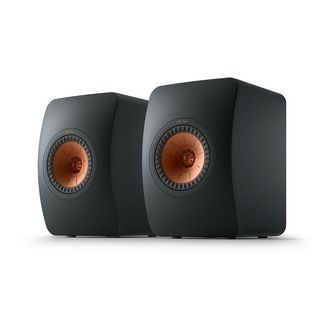
With innovative tech, exceptional performance, and unbeatable build quality, we'd recommend these to anybody.
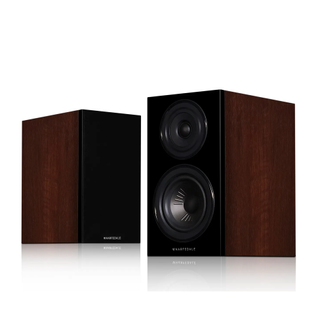
These budget-friendly Diamonds are wonderfully composed, refined and controlled for their affordable price.
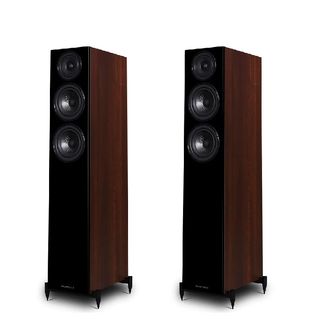
It’s tough to make a truly talented and affordable floorstander, but Wharfedale has cracked it with the accomplished 12.3.
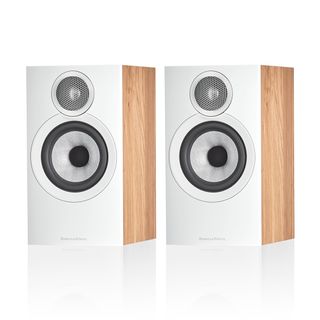
Open, refined, dynamically expressive and heaps of fun, new B&W's 607 S3 are the standmounters to beat at this price.
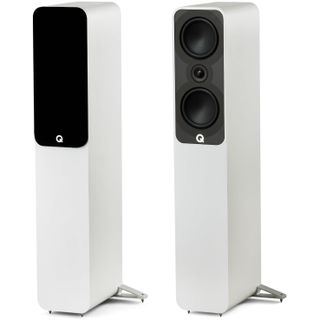
Insightful and entertaining, and has clarity, detail and dynamic flair in spades. Match them properly and they're truly brilliant.
Read more below
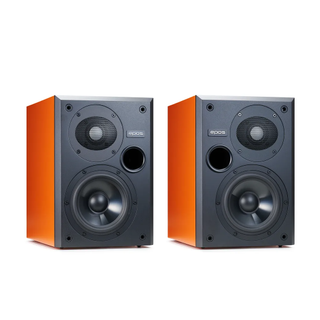
Petite premium speakers that are superb performers and are even optimised to be placed inside a bookshelf.
Load the next 3 products… ↓
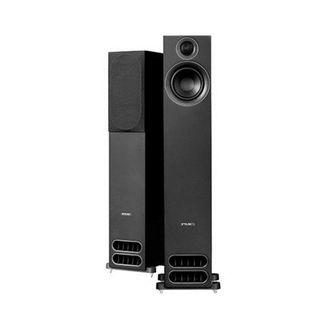
They make look plain, but these floorstanders deliver astonishingly refined and gorgeous sound, making them excellent value.

These retro-styled standmounters sound anything but old-fashioned, with a range of sonic talents that set them apart from their rivals.
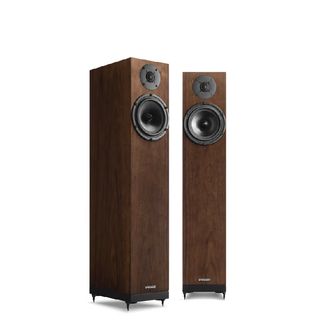
Refined yet entertaining, these are superb floorstanders that sound and look great, plus their relatively slim and compact dimensions mean they'll still fit into most homes.

I've been testing and reviewing speakers at What Hi-Fi? for over 12 years, and have listened to speakers of all shapes and sizes in that time. From budget pairs to premium models, the various speakers I have tested over the years have given me the knowledge and experience to know exactly what a buyer should be expecting for their money. Budget doesn't mean you should settle for shoddy build quality, and high-end doesn't mean you have to sacrifice fun for ultimate transparency and refinement. The best speakers should let you enjoy listening to your favourite music to the fullest, and the five-star recommendations in this guide aim to deliver exactly that.
Recent updates
29th January 2025: Updated our "coming soon" section with new speakers announced that we're excited to hear, as well as speakers we have in our test rooms that will be reviewed very soon.
Best speakers overall





Specifications
Reasons to buy
Reasons to avoid
The original LS50 speakers were absolutely terrific in their own right, but KEF eventually decided that they could do better. Eight years on from the original LS50, the LS50 Meta were born, and they've proven to be a truly worthy upgrade. And with multiple Award wins to their name, the LS50 Meta continue to impress us with their incredibly subtle, transparent and entertaining performance.
KEF reworked the LS50’s Uni-Q driver array, where the tweeter sits in the throat of the mid/bass unit, taking in all the refinements that KEF has developed over the past eight years and adding something new in the form of Metamaterial Absorption Technology (MAT). MAT is KEF’s way of coping with the sound that comes off the back of the tweeter dome via a circular maze of tubes on the back which absorbs sound more effectively and results in cleaner, less distorted highs.
And this works brilliantly – treble performance is more refined and clearer than before, and it's been such a success that the MAT technology has been implemented in many other KEF speaker ranges since.
While the basic sonic character is instantly familiar, the LS50 Meta have gained serious new levels of clarity and finesse that the original speakers couldn't manage. The speakers sound clean and tight, but they still offer muscle and dynamics to give your music plenty of oomph, character and interest. We said in our review: "Large-scale dynamics are handled well and there’s a good amount of muscle for a speaker of this size. These are refined and composed performers that rarely sound stressed unless volume levels are high."
As far as we're concerned, the LS50 Meta are some of the finest sound-per-pound (or dollar) speakers around and is compatible with a wide variety of partnering products. They continue to set the standard at this level to which others should aspire.
Read our full KEF LS50 Meta review
Best budget bookshelf speakers





Specifications
Reasons to buy
Reasons to avoid
Wharfedale's Diamond range of speakers has always had one mission: to offer top class sound at an affordable price. Over 40 years on, it continues to succeed in its mission. The current Diamond 12.1 standmount/bookshelf speakers have updated drive units and better cabinet construction, but these speakers remain as recommendable as when we first reviewed them in 2020.
The Diamond 12.1 have a bold, full-bodied presentation with plenty of detail. The speakers sound composed and refined, qualities that are rather unusual at this budget price point. They deliver more authority and scale than their modest price and size suggest, too, and while we don't expect bone-shaking bass from such small boxes, low-end notes sound full and dig deep enough to satisfy at this level.
Overall these speakers have a smooth tonal balance and a forgiving nature, but they have just enough bite and convincingly communicate the shifts in dynamics to keep you drawn to the music. There's ample rhythmic punch and subtleties in detail are admirable revealed at this level, too.
At this price, the Diamonds have faced serious competition from some excellent affordable speakers. We're still big fans of the expressive and agile Dali Spektor 2, while the multi-Award-winning Elac Debut B5.2 offer just a bit more rhythmic prowess and transparency. This Elac model has been discontinued, however, leaving the door open for the Wharfedale Diamond 12.1 to emerge as current budget favourites with their easy-going nature that will partner well with most components. You won't get a more crowd-pleasing performance at this level.
Read the full Wharfedale Diamond 12.1 review
Best budget floorstanding speakers





Specifications
Reasons to buy
Reasons to avoid
Wharfedale's Diamond range now features a truly outstanding (and affordable) floorstander. Indeed, we're so impressed by the Wharfedale Diamond 12.3's musical performance that it's a multiple and current What Hi-Fi? Award winner.
At 98cm tall, the Diamond 12.3 aren't a particularly imposing pair of floorstanders, so they'll fit into most spaces. Sonically, they're smooth, even-handed and wonderfully refined for the money. Feed them a poor signal and they’ll round off rough edges and downplay unwanted aggression without sounding like they’re smothering the life out of the music.
In our original review, we said: "Play them louder and these speakers don’t complain. They deliver Hans Zimmer’s raucous The Battle from the Gladiator OST with verve, tracking the brutal dynamics well. There’s punch and power when required, but also a level of subtlety that’s rare to find in a floorstander at this price."
The build quality is top-notch for the relatively modest price tag. The cabinets are crafted with a traditional straight-edge design and have a tidy feet arrangement for stability. These speakers are available in four finishes – black, walnut, white and a classy light oak – which is plenty of choice for most interiors.
If you're looking for reasonably-priced hi-fi floorstanders, the talented Wharfdale 12.3 are a superb buy.
Read the full Wharfedale Diamond 12.3 review
Best mid-price standmount speakers







Specifications
Reasons to buy
Reasons to avoid
Now in its eighth generation and going 20+ years strong, Bowers & Wilkins' 600 series of speakers has more often than not provided some superb speakers.
And that story continues with its latest entry-level 607 S3 speakers. The smallest and most affordable stereo speaker that B&W makes (even if that 'budget' price has increased in the last couple of years), the new 607 S3 replaces the previous Award-winning 607 S2 Anniversary Edition speakers and delivers a significantly improved performance.
The 607 S3 has been updated throughout, with a brand new 25mm titanium decoupled double dome tweeter, a new elongated tube loading system, a revised motor assembly for the 13cm Continuum mid/bass driver, higher-quality components used in the crossover, and sturdier cabinet bracing. The overlapping of the two drivers is designed to improve integration, and B&W says the titanium material should deliver more refined and detailed high frequencies.
The footprint remains the same and they're ideal for smaller spaces. Partner them carefully to balance out a somewhat forward, excitable treble performance, and you'll be rewarded with a terrifically detailed, rhythmically cohesive, agile, and energetic sound. The overall presentation is more open-sounding than before, while the treble performance is so much sweeter and more refined. For their size and price level, each note lands with precision and they even hold dynamic interest at low volume. Basslines are pulled taut and while they don’t go as bone-shatteringly deep as bigger speakers (or as big as the bigger, step-up 606 S3), they do land with impact.
Overall, they're just incredibly fun to listen to. There’s clarity and refinement in the mix here – to a really admirable level – but we’re struck by just how entertaining, zippy and musical this new pair sounds right from the start. We’re glad that, alongside a newfound level of clean detail, openness and precise sound, the new 607 S3 speakers have remembered to add in big doses of energy and dynamic prowess.
Read the full Bowers & Wilkins 607 S3 review
Best mid-price floorstanding speakers





Specifications
Reasons to buy
Reasons to avoid
Q Acoustics' new 5000 series sits in between the budget 3000 series and the premium Concept range. The 5040 is the smaller of the two floorstanders in the range (the step-up and more mature 5050 are also five stars and current Award-winners) and should fit neatly into most rooms, with a solid and well-made build quality.
The highlight of the range is the use of a new Continuous Curved Cone design for the mid/bass drivers. Q Acoustics claims that the geometry of this new driver combines the rigidity advantages of a standard conical cone profile with the high-frequency break-up characteristics of a more flared design.
Q Acoustics' previous efforts have tended to be unfussy, but these 5040s need a bit more care with positioning and partnering equipment. Match them with more refined partnering electronics (these speakers can be rather transparent, impressively so), and the 5040 sound wonderfully clear and precise, with ample agility and grip to deliver a sense of great fun. We like the way these towers always sound composed and controlled, and that sense of organisation doesn’t falter when the music becomes demanding. It's a spacious, well-focused sound with impressive stereo imaging. Tonally, these floorstanders sit just on the lean side of neutral, but not so far as to cause issues.
While the more expensive Wharfedale Evo 4.4 provide a sophisticated alternative, Q Acoustics 5040 are even-handed performers that simply step out of the way of the music and let songs shine. Take a bit of care with partnering amplification and sources, and these speakers will reward you with an expressive, insightful performance that is hard to beat at this price range.
Read the full Q Acoustics 5040 review
Best premium standmount speakers










Specifications
Reasons to buy
Reasons to avoid
While we (and most manufacturers) would advise you to place standmounter or bookshelf speakers on dedicated stands, Epos has made things a little more flexible. Recognising that it's not always viable for people to accommodate stands in their space, Epos has optimised its ES-7N small speakers so they sound their best even when placed inside a bookshelf.
Flip a switch at the back of these petite speakers and the speakers will adjust their performance accordingly when placed up against a wall or corner to remain evenly balanced. It's impressive just how close to the free-standing (away from wall, on stands) performance these speakers get when placed inside our IKEA Kallax bookshelf, and while there is a slight drop in clarity and stereo imaging, it remains a fantastic presentation overall.
In fact, even though these are small boxes that won't compete with larger designs – such as KEF's R3 Meta, which offer deeper bass, bigger and more dynamic sound – what these Epos speakers do so well with music gets us smiling with joy and our feet tapping. They're incredibly talented.
As we said in our review: "The ES-7N are bold and confident performers that resolve high levels of detail and organise it in a cohesive and musical way. Play Kendrick Lamar’s Not Like Us and the Epos kick like a mule. They sound taut and punchy with music such as this, delivering the song’s jumpy rhythm track in a wonderfully surefooted manner. There is plenty of drive here and the speakers are great at conveying the music’s varying momentum."
Voices are delivered with impassioned nuance and clarity, and bass notes are – for such small cabinets – taut, solid and grippy. We love the similarly-priced Neat Petite Classic's fun, peppy presentation, but the Epos are even more precise and controlled when it comes to rhythmic agility. They are just as considerate with more classical or intimate recordings, and they pair well with a variety of amplifier partners, from the budget Rotel A8 to the premium Naim Nait XS3.
The Epos ES-7N are charming performers. They are small, hugely capable and surprisingly unfussy in use. That they recognise not everyone will be able to position their speakers perfectly and sound just as good when placed inside bookshelves is a rare talent that should be celebrated. If your budget can stretch this high and you have a small space to work with, these are highly recommended.
Read the full Epos ES-7N review
Best premium floorstanding speakers





Specifications
Reasons to buy
Reasons to avoid
PMC has something of a reputation for high-end hi-fi, and while the superb Prodigy 5 have wound up as our best premium floorstanders on this list, they're actually miraculously good value.
The priority with the Prodigy 5, much like their five-star Prodigy 1 standmount siblings, has been to eke out as much sound-per-pound punch as possible, letting considerations over design and aesthetic flourishes fall away in the pursuit of the best audio you can get for the price.
And boy has the effort paid off. PMC has hit the sweetest of sweet spots with the Prodigy 5. The speakers balance subtle details and musical flourishes with a heightened sense of presence, poise and confidence. In terms of sonic performance, we didn't hear many better new speakers in the last year, and it was the Prodigy 5's musical chops that really earned them a current What Hi-Fi? Award.
The Prodigy 5 are adept at giving the best of all worlds without a hint of sonic sacrifice. While comparatively priced rivals substitute space for precision or dynamics for subtlety, PMC’s unassuming towers are truly comprehensive performers. There's so much scale and breadth to them, yet they never seem to sacrifice the intimacy or nuance of a piece, either. It's a remarkable trick, and one that had us wanting to test more and more tracks to see what the Prodigy 5 could do with them.
All in all, a marvellous success story. Worthy winners, indeed.
Read our full PMC Prodigy 5 review
Best high-end standmount speakers






Specifications
Reasons to buy
Reasons to avoid
For these Mission 770 speakers, the brand took design inspiration from the original 770 speakers launched in the 1970s, but improved and modernised every other element: from the cabinet design to the drivers and even new dedicated stands.
While the retro link will be the main attraction for some, for us that’s put in the shade by the speakers' excellent all-round performance. The 770 have a range of sonic talents that sets them apart from most rivals and earns them a warm recommendation.
They have so much finesse when it comes to delivering extended bass. Bass textures and low-level information are delicately conveyed, while they sound taut and agile even with the most intricately composed songs. There's plenty of punch and power, too. The speakers have a slightly forward balance, especially with the clear and expressive midrange, that sounds lively and engaging – but thankfully never too aggressive.
Stereo imaging is impressive, too. We said in our review: "It’s layered and nicely focussed... pleasingly, the imaging remains stable even as the music becomes more demanding."
Songs are delivered with wide-ranging dynamics, impressive authority and scale. It’s a musically cohesive presentation that’s controlled and nicely organised. If you have the budget - and space - for these speakers, they're worth an audition.
The Epos ES14N are a viable alternative, and if your budget can stretch to them, the KEF Reference 1 Meta also come highly recommended.
Read the full Mission 770 review
Best high-end floorstanding speaker


Specifications
Reasons to buy
Reasons to avoid
The big brothers of the A-Line series, these Spendor A7s are superb floorstanders that sound great, look great and are compact enough to fit into most homes.
Build quality is of a high standard, with crisp edges and impeccably smart wood veneer finishes in a choice of black ash, dark walnut or natural oak – there’s also a satin white option (for an additional fee). These long-running speakers may have increased in price over the years, but they remain wonderfully capable performers at this premium end that will richly reward you.
Each speaker has an 18cm mid/bass driver and a 22mm tweeter with a wide surround to disperse the sound even further. Performance is refined yet entertaining, combining stunning precision, clarity and subtlety with hugely enjoyable dynamics and rhythm. They time with pinpoint accuracy and are immensely transparent – without straying into 'clinical-sounding' territory. In our review, we played songs from Lorde, Massive Attack and Ólufar Arnalds, and said the "Spendors remain agile and controlled throughout, handling each musical strand like a veteran puppet-master."
It’s worth taking care when partnering them, though. The A7s will work happily with most capable amplifiers, but something like the powerful yet poised Roksan Blak amplifier or Naim Supernait 3 will add a touch more warmth to the overall sound.
If you’re in the market for a new pair of top-notch floorstanding speakers, these elegant Spendor A7s should make their way to the top of your list.
Read the full Spendor A7 review
Also consider
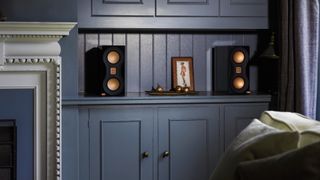
There are plenty of excellent speakers that we couldn't fit into the main list above, so here are some more alternative options, both new and old, that we would recommend to anyone looking for a new pair of speakers.
Dali Spektor 2: As an alternative to the budget Wharfedale Diamond 12.1, these long-running Dali speakers are a firm favourite, with a natural warmth to the midrange that conveys passion and nuance with voices, and fluid dynamics that make them appealing and entertaining to listen to.
KEF R3 Meta: There's no doubt that the R3 Meta remain some of the best premium standmounters on the market. Wonderfully transparent, refined and entertaining performers that have been built to the highest standards, they deserve a place on your shortlist if you want a large, wide soundstage and more punch.
Neat Petite Classic: If you're limited on space but want high-quality sound from a very small footprint, these Petite Classic speakers are terrific fun. Their dimensions won't allow for huge scale or bass extension like the KEF R3 Meta, but we're won over by their terrific rhythmic precision and agility, solid sound and fun presentation.
Q Acoustics 5050: If you're able to extend your budget further than the Q Acoustics 5040's asking price and can accommodate larger speakers, these flagship and Award-winning 5050 floorstanders are worth serious consideration. They deliver a more balanced and mature presentation over the 5040s, with the extra authority and detail more than justifying the step-up in price.
Wharfedale Evo 4.4: Former Award-winning floorstanders that remain competitive, with an organised, transparent and subtle way with music that rewards long-term listening. These speakers go loud easily and strike a nice balance between attack and smoothness.
Sonus Faber Lumina V: Elegant Italian charm in aesthetics and sound. These classy-looking floorstanding speakers are articulate and refined, and deliver ample bass depth and authority, but remain an easy-going, composed and charming listen.
Fyne Audio F502SP: If you're after large-scale thrills, these high-end Fyne floorstanders will wow you with their breathtaking scale and solidity. Immersive dynamics and rock-solid stereo imaging are their strengths, and they trade in a touch of sonic sophistication for outright energy and thundering bass power.
Epos ES14N: They may not look that impressive, but these large standmounters are mighty impressive when it comes to analysis, organisation and control. Low-level detail and dynamics are revealing, while they have an open, articulate way with voices. We'd perhaps like a bit more rhythmic drive, but we can't fault the stunning clarity and cohesion on offer.
Stereo speakers coming soon
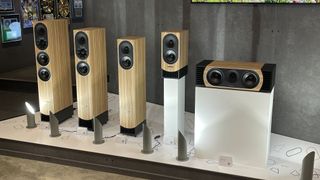
- Fyne Audio F5E and F501E: Fyne's new entry-level F500E speaker range now feature the brand's IsoFlare point source driver technology, previously reserved for higher-end models only. We have in our test rooms the smallest bookshelf F5E (£399) pair and the floorstanding 501E (£999). We'll be putting both pairs through their paces in the next month.
- Elac Debut 3.0 DB53-BK: We've been waiting to get our hands – and ears – on Elac's new budget Debut 3.0 series, as it replaces some of our favourite Award-winning budget speakers. We have the DB53 bookshelf model (£299 per pair) in our test rooms and will be testing them next month.
- PMC Prophecy series: PMC has just launched a new premium range of speakers that we're excited to hear this year. The range consists of a standmount pair, three floorstanders and a centre speaker, with prices ranging between £2275 to £8975.
- Acoustic Energy 300 Series: An entirely redesigned range of mid-to-premium models, with drive units derived from its flagship Continuum speakers. Prices span £649 for the AE3002 standmount and £1,999 for the AE3202 floorstanders.
- Quad ESL-2912X: It's been 12 years since the last electrostatic speaker from Quad, so anticipation is high for this next-gen model launching this summer. We are big fans of the current ESL-2812 speaker, but the upcoming 2912X is positioned as the new flagship with upgrades inside and out.
- Wharfedale Super Linton: With extensive upgrades to the cabinet, crossover and drive units, the Super Lintons are a step-up version of the excellent Wharfedale Lintons from 2019, which we called "undeniably superb" in our five-star review. Price is £1999 / $2499 / AU$5199 with stands.
How to choose the best speakers for you
First things first, decide on a budget. Your components should be evenly matched, both tonally and in terms of price, so consider this before breaking the bank on a new pair of speakers that the rest of your kit can't do justice to.
You also need to make sure your speakers fit your room. Most speakers require a degree of space to sound their best, so be sure not to buy speakers that are too big for your listening area. This is also a good time to consider whether you want bookshelf or floorstanding speakers. Bigger speakers mean higher volumes but, again, you need the space.
It's also worth checking that your system's amplifier can comfortably drive the speakers, and that the sonic character between each component in your system match up. A bright-sounding pair of speakers can sound too hard or harsh when paired with equally bright/top-end heavy partnering equipment, so it's worth reading multiple reviews or – if you're able to – demo the speakers before taking the plunge. If you'll be buying high-end models, it's worth having a conversation with the dealer and taking time to match your system.
There's also the choice between passive or active speakers. All the speakers on this list are passive: i.e. they have no amplification built-in, and so require a separate amplifier to work. Active speakers or powered speakers with amplification inside (and sometimes DAC and streaming smarts) are increasingly popular and can connect straight to your source, no amp required, though they do require a connection to mains power. Check out our pick of the best active speakers or best desktop speakers if you're curious about this alternative.
For a more detailed explanation of everything you should consider, check out our complete guide to choosing the right speakers.
How we test speakers
The What Hi-Fi? team has more than 100 years of combined experience in reviewing, testing and writing about consumer electronics, from hi-fi to headphones to TVs. We have state-of-the-art, acoustically treated testing facilities in London and Reading, where our team of experienced reviewers conduct all our in-house testing, including all stereo speakers. This gives us complete control over the entire review process, ensuring consistency across all our listening.
When testing speakers, we ensure we position them in the correct place in the room, partner them with price-appropriate source kit and amplifiers, and play a variety of music genres when reviewing. Check out our ultimate test tracks list for the various types of songs we use to test speakers, including specific elements such as treble, bass, dynamics and vocals. We make sure we run in each pair of speakers and spend plenty of time with them, and we try various partnering amplifiers and sources, and different positions (including placing on stands where needed) to ensure we give the best advice to buyers.
What Hi-Fi? is all about comparative testing; all products we review are tested in comparison with rival products in the same category and at the same price point, and each pair of new speakers is always listened to by two to three members of the team. All final review verdicts are agreed upon by the reviewing team as a whole, rather than a single reviewer, to ensure we avoid individual subjectivity and are consistent across all our reviews and verdicts.
We pride ourselves in the fact that our reviews are 100% independent, with no input from manufacturers, PR or commercial teams. This means that if you take the plunge and buy one of the products recommended in this buying guide, or on any of our other Best Buy pages, you can rest assured you're getting a What Hi-Fi?-approved product.
You can read more about how we test and review products on What Hi-Fi? here.
F.A.Q
Are bookshelf speakers better than floorstanders?
The short answer is: it depends. For the long answer, you might want to peruse our standmounts vs floorstanders article, where we go into more detail about the differences between the two types of speakers, and the advantages (and disadvantages) of each.
A lot will depend on the size of your room. Floorstanding speakers typically need more space to breathe in, while bookshelf (or standmount) speakers can be placed in smaller rooms or surfaces. Of course, if you'll be using speaker stands with your bookshelf speakers, you'll need ample space for these too. Loudness levels are another consideration: if you have a large living room, will compact bookshelf speakers be able to fill the space satisfyingly? Floorstanders' large cabinet volume will tend to deliver a bigger scale of sound – it really depends on what your sonic tastes and home system's needs are.
If you'll be using your speakers for movies as well as music, or simply favour lots of deep bass, then a larger cabinet is the way to go. If the only place to put your speakers is on your desk or you'll be sitting close to your speakers, you'll want small bookshelf units. Just bear in mind that the quantity of bass doesn't necessarily equate to better quality of bass, and how a speaker is engineered to deliver the best balance and quality of sound differs from model to model, and should be taken into consideration before buying.
Recent updates
- January 2025: Updated "coming soon" section with new speaker launches and models we are reviewing next month.
- December 2024: Added a new "coming soon" section detailing the new speakers announced and that we will be reviewing in the coming months.
- November 2024: The Epos ES-7N and Wharfedale 12.1 have been added to the list following their 2024 What Hi-Fi? Award wins.
- September 2024: The new Dali Rubikore 2 replaces the KEF R3 Meta as our premium standmounter choice, but the R3 Meta remains a good alternative and has been added to our Also Consider list.
- July 2024: The new five-star Monitor Audio Studio 89 speakers have been added to the Also Consider list.
- June 2024: No new entries, but added the new five-star Q Acoustics 5050 to the Also Consider section, and added image galleries.
- March 2024: Added an Also Consider section to offer even more choice of speakers across all budgets and types.
- February 2024: Updated our 'how we test' process and added a FAQ section to help buyers in their decision to buy hi-fi speakers.
Today's best deals
Get the What Hi-Fi? Newsletter
The latest hi-fi, home cinema and tech news, reviews, buying advice and deals, direct to your inbox.

Kashfia is the Hi-Fi and Audio Editor of What Hi-Fi? and first joined the brand 13 years ago. During her time in the consumer tech industry, she has reviewed hundreds of products (including speakers, amplifiers, turntables and headphones), been to countless trade shows across the world and fallen in love with hi-fi kit much bigger than her. In her spare time, Kash can be found tending to an ever-growing houseplant collection and shooing her cat Jolene away from spinning records.
- Tom Wiggins
- Harry McKerrellSenior staff writer
-
Sliced Bread Or ATC / PMC, but to be fair the list cannot go on for ever :)Reply
Anyway PMC seem to have priced themselves out. The GB1i was released at £1500 back in 2008 and was their entry level floor stander. The equivalent now is the Twenty5 23i of e £3850. I’m sure they’re better, but as a small entry level speaker is it £2350 better? The reviews indicate not. -
Reply
Couldn't agree more. British made speakers are becoming damned expensive.Sliced Bread said:Or ATC / PMC, but to be fair the list cannot go on for ever :)
Anyway PMC seem to have priced themselves out. The GB1i was released at £1500 back in 2008 and was their entry level floor stander. The equivalent now is the Twenty5 23i of e £3850. I’m sure they’re better, but as a small entry level speaker is it £2350 better? The reviews indicate not. -
Jpanic4 I noticed that the Triangle Br03 is not on the list anymore. Would you not consider them for this list anymore?Reply -
AndyS OMG what a bad review, ok the budget end and perhaps the mid price range is ok, I might disagree with most of their choices but that's personal. When they move on to the top end and the most expensive speaker is £3300 that is a joke. Ok it is a lot of money but to say they are the best speakers in the top end of the market is a farce.Reply -
nopiano Reply
Yes, the terminology needs some work, as even the magazine’s own best buy listings include ATC actives and Martin Logan electrostatics, to name just two!AndyS said:OMG what a bad review, ok the budget end and perhaps the mid price range is ok, I might disagree with most of their choices but that's personal. When they move on to the top end and the most expensive speaker is £3300 that is a joke. Ok it is a lot of money but to say they are the best speakers in the top end of the market is a farce. -
Quadrophonic.4Ever What no "Theophany" speakers?Reply
One surely cannot state "the best" without trying all available, otherwise the best (you decide upon) are in fact limited by your inability to source AND TEST all speakers, sourced from "everywhere around the world", not just from within your own country, or even from within your closest city.
One must test ALL, from any country world wide.
So?
What about New Zealand's Theophany Speakers?
I'm sure Garth would love to explain all he knows, about the speakers he designed.
I know his speakers, as I went there one time, to showcase my surround sound system, such that I wasn't at all impressed that he didn't let me try his speakers.
Instead "insisting" that I set up (whatever I had brought with me), in a small OUTSIDE grassed area, underneath some trees, between a couple of corrugated iron sheds - which did absolutely NOTHING to enhance the way my total "surround" sound system, was heard as.
Unlike his own "inside the house" set-up, which was in a dedicated sound "player" room, where he INSISTED that I sit in a "precisely-in-the-center" master listening position.
Thus:
He listened to mine, (in an off-hand walking around method, outside (between a couple of tin sheds, under the trees), whilst he tried to tell me HIS system was way better, in a dedicated sound-proofed room, with several frequency split multiple speaker "channels" , containing a lot more speakers, than the miserable (cheap) small box speakers I had brought with me, (as a backup in case I wasn't allowed to, or couldn't be supplied with enough, of anyone else's speakers).
Hence why, after being TOLD to sit in one place and admire the "best position" to hear a movie he played (on a huge TV), I deliberately got up and (having asked him to keep it playing, as he stopped it as soon as I stood up) I deliberately walked around his (demo) room, as well as into various corner areas, and out the back towards his kitchen/lounge areas, to "hear" the various nodes and dead listening areas, all the while turning towards him and commenting on the different "sweet spots" that were or WERE NOT in that environment, until I found the one position where the sound actually self-cancelled itself out, with almost no sound at all.
THAT was when I said, well - your system doesn't sound as good as the cheap speakers I used OUTSIDE, when standing here, pointing down to my feet (in the archway between the demo room and his kitchen).
I was ushered out into his speaker "parts" room (behind his outside workshop shed) to be shown some new unboxed speakers, that he took one of, and with absolute carelessness, hooked some test wires onto it's exposed back "terminals" to play some TEST tones through, which sounded absolutely horrendous, as if a burnt out coil was "rubbing" on it's magnetic core, whereupon he got one of his elder sons, to swap the test tone frequency (in a different room area, out of my sight) and then changed the polarity of his "test leads", to again play the same (or similar) test tones, far clearer and louder, after which he tried to tell me that the PHASING was all that much better with the system polarised correctly, however being an Industrial Electrician, I told him, that simply reversing the terminals does absolutely nothing, to a speakers actual sound, as the speaker gets an alternating current, (of several different frequencies with differently played TONES - which reverses the "played" frequency polarities way faster than a person can flip a switch, on each and every sinusoidal waveform's highest & lowest peaks, even if a single tone is generated to run a test, not like the "music" which he was using, which already had a LOT of different frequencies within it, all peaking at different rates, thus pushing and pulling that non-mounted speaker in every direction since Sunday.
Thus, I (an outsider with good spacial awareness to the sound made by various electrical pulses), told him, that his so-called reasoning between my outdoor cheap speaker boxes, and this open backed non-mounted speaker, were idiotic to compare, given that the speaker he "held" in his hand couldn't be described as better, given the way he was holding it.
Up and closer to me in the second playing.
I told him, that even if it had been "clamped" in a set position, without any box to hold it's back-pressures within, it's diaphragm would still over extend on each available maximum equated peaks, given the different numbers of cycles each frequency used, during his so-called tests, where I couldn't see what was being played, or whether or not any bass, treble or volume settings had been altered.
As the test equipment was in another room of his workshop, out of sight from where he was holding his single speaker, with me being placed even further away from the other room.
He was actually slightly angry, that I pipped his arrogance, as I am sure he had assumed I wouldn't know the test settings had been changed, to back his claim that a speaker's polarity made any difference, or that his obviously way more expensive speaker/s were of a different class, to the cheap speakers I had used.
Thus, I am not convinced, that your "own" suggestions of better or best speakers are the actual best.
My responce is this.
To your own article of:
"""Your curated list of the very best stereo speakers you can buy for your money"""
As regarding your article on the main What Hi*Fi website, on:
Whatever you budget and requirements, these are the best speakers you can buy.
re:
{quote]Dec 19, 2019
Best speakers 2024{unquote]
???
Did you (at any time) use an SPL meter, placed 1M from each tested speaker, to get a genuine comparison of perfection, before making the claim of "best" anything.? -
Quadrophonic.4Ever The 126.3dB "tested SPL result" (2003 NZ National Sound-offs) - obtained from WITHIN MY VAN (fitted with the cheapest "ad-hoc" speakers) using a 7.3+1 surround sound system that I invented back in 1965, and which I had hand-built myself, into my 1996 Mitsubishi Delica 4wd 7 seater van, with (at that time) the rearmost 3 seat bench unit had been removed, whilst I had the rear hatch OPENED UP, and the two front doors "open" and all windows also open.Reply
Just because I wanted everyone in the park at that year's Blossom Festival, to hear the quality of sound, rather than a simple BASS loudness.
I was told to close all my windows and doors, for the second run, which I did WITHOUT the four sub & sub/subwoofers running, to ensure that neither my closed windows nor my windscreen would crack with any extension pressure thus created, and that I wouldn't have to "high output my Bass speakers," letting just the main channel speakers and the tweeters, to RUN HIGH and without any of the Neon and fluorescent lights operating, which resulted in a crispier higher tone sound, and a DROP of just 0.3 Db at 123.0 Db.
I had been laughed at, by almost all contestants there, when trying to get my van "included" in the sound-off contest, but most of the jaws that had been flapping with SMART comments beforehand, (about the motley collection of old 2nd-hand speakers in the van) stopped making derogatory noises afterwards.
I placed third overall.
Not bad for an OLD DAD.